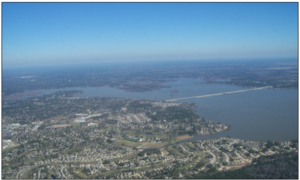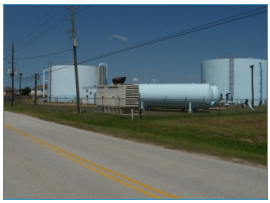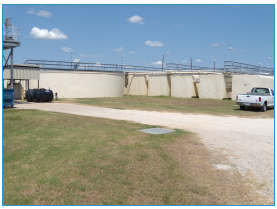WATER: THE FLOW
Where Does Our Water Come From?
When municipal utility districts are created, a drinking water source is identified. When MUD 127 was created in 1975, water was sourced through a well located within the district. A second well was drilled in 2004 in the neighboring district of Harris County MUD 239, and is jointly accessible to both MUD 127 and MUD 239.
However, due to an excessive amount of subsidence along the Gulf Coast, a state-government directed plan was implemented whereby MUDs in our area must reduce pumping water from underground sources and utilize surface water. In the case of MUD 127 and other MUDs within the West Harris County Regional Water Authority, water is now purchased from WHCRWA, who has contracted to purchase water from the City of Houston and piped from Lake Houston, Lake Conroe and Lake Livingston.
Lake Houston is a shallow reservoir on the San Jacinto River. It was constructed by the City of Houston in 1954. More information about Lake Houston can be found at http://pubs.usgs.gov/fs/fs-040-02/fs040-02.htm. Lake Conroe was constructed in 1973 by the San Jacinto River Authority as a water supply reservoir through a joint venture with the City of Houston. Learn more about the development of Lake Conroe at http://www.sjra.net/lakeconroe/.
At 83,000 surface acres, Lake Livingston is the largest single-purpose reservoir in Texas. Built and operated by the Trinity River Authority under contract with the City of Houston for water supply. It was completed in 1969. Read more about it at http://www.trinityra.org/.

Our Consumption
Water consumption can vary year to year, depending on the amount of rainfall. During calendar year 2021, water consumption in our district was slightly more than 204 million gallons, an average of 6,456 gallons per household per month.
Also in 2021, approximately 311 million gallons of wastewater from our sanitary sewer system was processed at the Wastewater Treatment Plant, and roughly 175 dry tons of sludge was removed. The plant is designed to treat 1.15 million gallons per day of wastewater and is currently treating approximately 865,000 gallons per day.
Our Drinking Water
The water drawn from the aforementioned lakes goes through a series of filtration and treatment processes in order to bring it to a quality level required by the Environmental Protection Agency (EPA) and the Safe Drinking Water Act. These processes make it safe for consumption by the public. The treated water is pumped through a series of pipelines to the WHCRWA facility not far from our District and then re-pumped to MUD 127’s water plant, where it is re-checked for quality standards and re-treated as needed to ensure it remains safe to drink. Next stop: the taps in your home.

The water plant is managed by H2O Consulting, the Operator for MUD 127. H2O tests the water at regular intervals to ensure that it meets safe drinking standards, and each year produces and mails to residents the Annual Water Quality Report, which contains detailed information about the levels of certain substances in our water. Click to see the most recent report below, along with reports from previous years:
Emergency Alerts
The EPA requires that residents be notified if the water becomes unsafe to drink. If for any reason at any time our water should become unsuitable for drinking, H2O will issue an emergency alert. MUD 127 customers will be notified by a door notice, with specific information and directions. An alert will also be posted at the District’s website and via the District’s Text/Email Alert System.
Drought Conditions
In the event of drought, the Board of Directors may determine that restrictions on water use — either voluntary or mandatory depending on the severity of conditions — should be implemented. A Drought Contingency Plan prepared by the District details the requirements and level of restrictions that may be implemented. Click the link below to see the most recent plan.
Drought Contingency Plan (PDF)
Wastewater
The wastewater generated by normal life activities (bathing, washing clothes, dishes and pets, flushing toilets, etc.) flows through underground sanitary sewer lines. These underground lines carry the waste to a lift station which, in turn, pumps it into tanks at the district’s sewer plant.

In the tanks, the waste undergoes several treatment processes required by the EPA before it merges with other water in the Harris County system of drainage channels.
Stormwater
What happens to the runoff from rainwater and lawn watering, along with the liquid waste streams we generate through daily activities in our homes and commercial buildings? Ultimately, it all flows to the Gulf of Mexico — and that’s a very good reason to be concerned about what goes into our liquid waste streams.
Storm drains along our streets collect rainwater and runoff and funnel it through a storm sewer system to the creeks and bayous that wind their way to the Gulf. Environmental laws require that storm sewer lines laid within the last 10-15 years have storm water treatment units installed, which help to catch grit and “floatables” (e.g., plastic bottles) before they reach the creeks and bayous. Lines placed prior to the enactment of environmental laws have no such barrier, and unfortunately, sediment and manmade solid wastes are able to make their way into the storm drainage system.
To help alleviate the problem, MUD 127 employs a company that conducts a quarterly cleanup of the drainage lines in the district. Every resident can help by keeping solid waste such as grass clippings and branches away from storm drains.
UPCOMING MEETINGS
Monday, May 13, 2024 at 12:00 PM
The District’s Board of Directors generally meets on the second Monday of the month at noon at the office of Strawn & Richardson, 1155 Dairy Ashford, Suite 875, Houston, Texas 77079.

